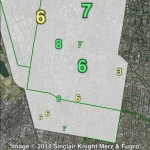 Prahran has been the stand-out seat in terms of late counting for the Victorian state election. While every other seat has now been decided, Prahran remains too close to call – with three different candidates still in the running.
Prahran has been the stand-out seat in terms of late counting for the Victorian state election. While every other seat has now been decided, Prahran remains too close to call – with three different candidates still in the running.
At first glance, it appears that Liberal MP Clem Newton-Brown is narrowly leading Labor candidate Neil Pharoah after preferences by 41 votes. While that is extremely close, most votes have now been counted on a ‘two-party-preferred’ basis between Labor and Liberal, so this in normal circumstances would have put Newton-Brown in a strong position to win.
But Pharoah is only 426 votes ahead of the Greens’ Sam Hibbins on primary votes, and is in serious danger of falling behind the Greens based on preferences from minor parties.
In terms of primary votes counted, it appears that most votes have been counted. A Greens scrutineer told me that they expect approximately 100 more votes to be added to the count. It is worth noting that on Sunday another sixteen Greens votes were found, which will narrow the Labor lead over the Greens slightly further.
With a gap of 410 votes, there are then another batch of votes for candidates other than Labor, Liberal or Green. At the time of writing, there are 1,669 votes cast either for the Animal Justice Party, Family First or one of three independents. Almost half of these votes are for the Animal Justice Party, who preferenced the Greens.
The Greens have had a large team of scrutineers covering the count, with a more limited presence from Labor and Liberal. The Greens have tracked preferences from those minor candidates, and believe that they will gain enough preferences to overtake Labor.
If the Greens overtake Labor, there will be a lot more uncertainty about the result, since the VEC has not been undertaking an indicative Liberal-Green count in the way they have for Liberal-Labor. The Greens will need to gain about 83% of preferences from Labor and the minor candidates, which is a big ask, but evidence from scrutineers suggests that the Greens have a chance of winning.
Later today, the VEC will be undertaking the distribution of preferences, which will determine who out of Labor or the Greens will come second and challenge the Liberal MP for the seat. It’s certainly worth watching.
If the Greens manage to win despite coming third on primary votes, it will be a rare result without many precedents. In recent years, the only examples I am aware of were the 2009 Frome by-election in South Australia and Denison at the 2010 federal election – in both cases an independent won from third place. Prahran would also be the first time in Australia that the Greens have won a seat off the Liberal Party.
In the meantime, continue reading below the fold for some analysis of the booth results in Prahran.
There are fourteen booths in Prahran. Twelve of these booths were used for Prahran in 2012. I should note that for my pre-election analysis I transferred Toorak Central from Prahran into the neighbouring seat of Malvern due to the redistribution. Toorak Central has been used again, but a substantial number of voters in the area who voted at that booth in 2010 would now be in Malvern.
I’ve split booths into the same three areas as I used in the pre-election guide: central, north and south.
| Voter group | LIB % | ALP % | GRN % | LIB swing | ALP swing | GRN swing | Total |
| North | 51.85 | 22.24 | 22.29 | -3.72 | -2.27 | 6.12 | 9,072 |
| Central | 41.24 | 26.72 | 26.90 | -1.41 | -4.80 | 5.94 | 5,090 |
| South | 31.67 | 30.91 | 32.70 | -3.69 | -1.88 | 6.57 | 4,701 |
| Other votes | 45.83 | 26.15 | 23.22 | 0.22 | -2.03 | 2.69 | 17,848 |
Overall, the Greens have gained a swing at every booth, ranging from 3.3% at Orrong to 8.2% at Prahran. At some booths, this mostly came from Labor while the Liberal vote held up well or increased (Hawksburn Central, Prahran) while in others the Liberal vote dropped and Labor stayed steady (Alma, Balaclava, Fawkner Park, Hawksburn) and in a few others the Greens swing came at the expense of both parties. I think this suggests that the Greens gained votes from both parties, but it’s impossible to be sure.
Overall, the Greens swing was reasonably steady between the three areas, but much weaker on the special vote. Labor was particularly hit hard in the centre of the electorate, with the Liberal Party suffering larger swings in the north and south.
The following charts show the primary vote for the three main candidates and the swings for their parties on the primary vote.
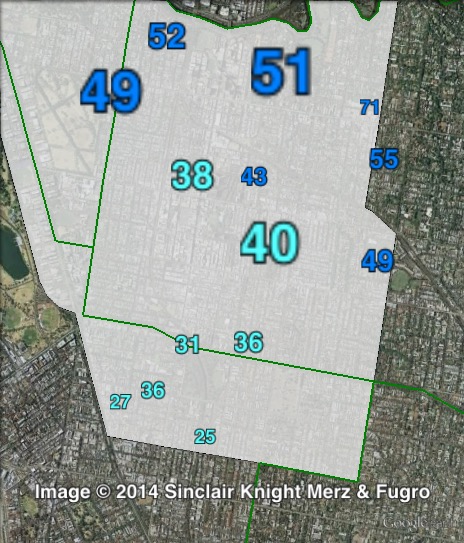
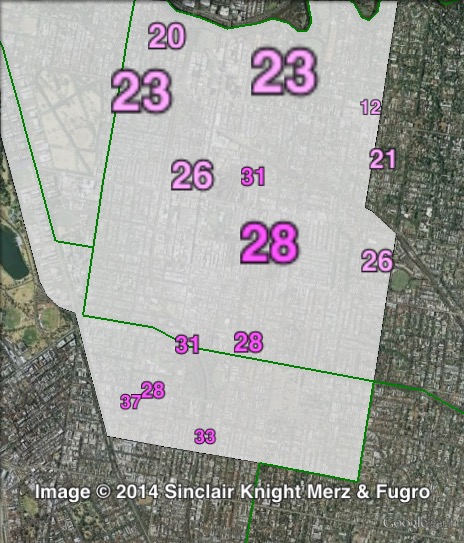
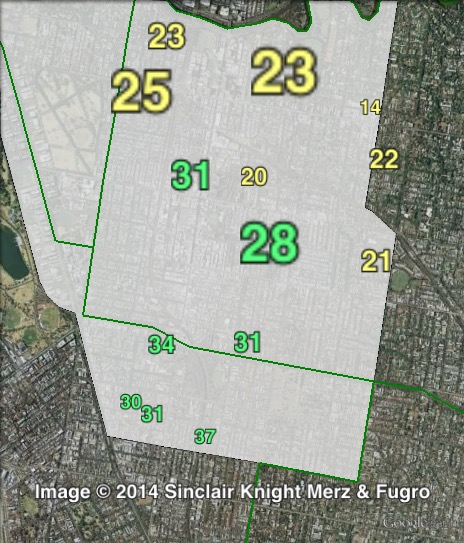
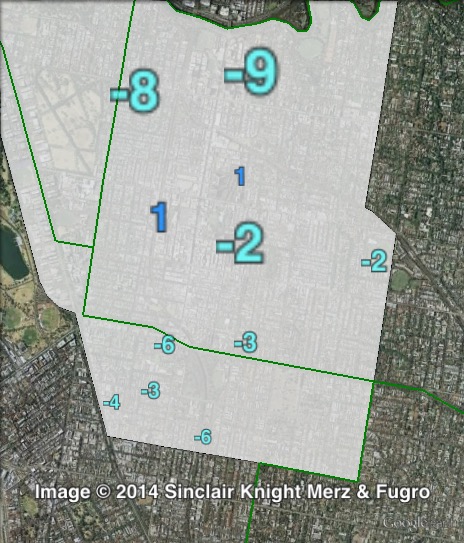
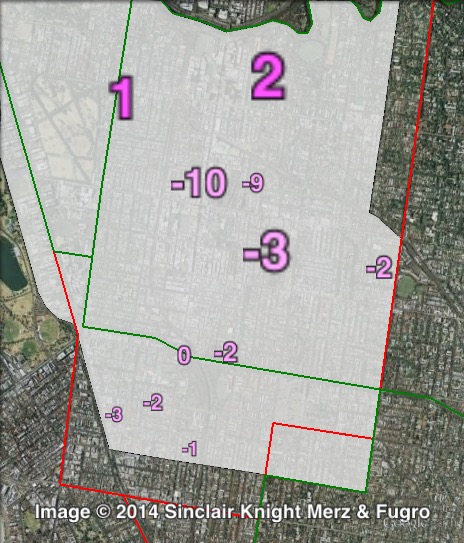
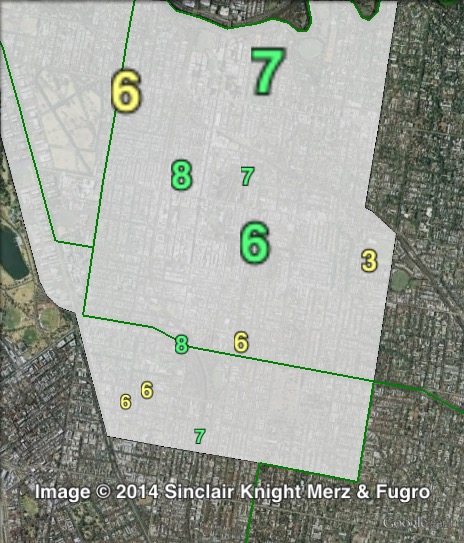



Blair 1998 was another example of a candidate winning from third. Liberal Cameron Thompson overtook Labor on the distribution of National preferences and defeated Pauline Hanson on the distribution of Labor preferences.
I make the rate required for the Greens on current primaries 83.1% of preferences ahead of the Liberals, and I expect it to drop slightly too.
Oops you’re right. Not sure how that happened.
There have been seven cases of a third on primaries victory in the Commonwealth elections.
Forest 1949, Wimmera 1958, Batman 1966, McMillan 1972, Fairfax 1990, Blair 1998 and Dension 2010. Denison is the only example without either the Nationals or the DLP in the count. Wimmera is the only without an independent.
There was one in NSW in 1984 (under OPV!). I do not know about under compulsory preferencing. There is the Frome example in SA in 2009 but I do not know about before that. I expect that there have been victories from third place in Queensland (pre-1992), other NSW (pre-1980), Victoria and WA but most of the seat level state election results are not on the internet (that I know of).
Also, it should be noted that the Greens have taken lower house seats off the Liberals at the state/territory level in both Tasmania and the ACT, and also in the Federal Senate (For example, Larissa Waters in Queensland), and no doubt in other upper houses around the country. If they do win it, it may well be the first time they win a seat from the Liberals in a single-member constituency.
Tasmania’s Legislative Council has a single-seat system and although the mainly independent fields make for a lot of close multi-way primary contests, there are only three cases of a win from third and none from further down. Wins from third in Newdegate 1986, Hobart 1938 (winner was third by 1 vote), Hobart 1916.
Any update as of close of business today?
I believe the distribution of preferences will take place tomorrow.
Larissa Waters in Queensland was off Labor, not the LNP – remember that 80 of the Greens vote is drawn from Labor
The Greens came pretty close in the 2001 Nedlands by-election, after Richard Court resigned. They came third, got ahead of Labor on Libs for Forests preferences, and then got to within 3.5% of the new Lib candidate on Labor preferences. (Probably the most marginal that blue-ribbon seat has ever been.) Another few points, and it could’ve been a boilover right up there with Burwood and Benalla.
I find it extraordinary that the VEC is still showing a 2PP count as between Labor and Liberal, without even an annotation explaining that this may not be the count that counts in the end. It’s good that electoral officials don’t have too much of a sense of adventure, but they could develop an ability to communicate!
I am posting updates when I find out anything at http://kevinbonham.blogspot.com/2014/11/victorian-election-postcount-prahran.html
2PP gap is currently 11 votes, but the Greens have closed in to 405 behind on latest primaries I can see.
Greens ALP gap now 397
Definitely a psephological cliff hanger
Comments are closed.